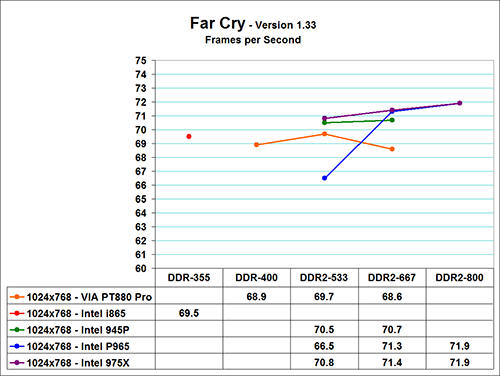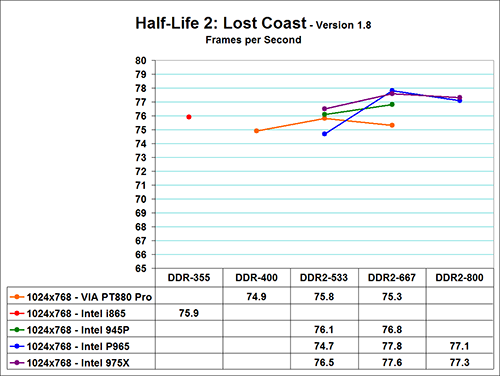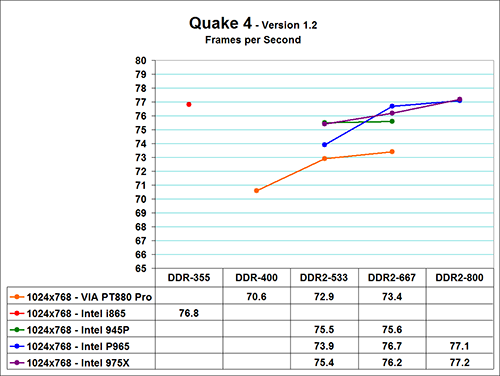Intel Core 2 Duo: Memory Performance Part Deux
by Gary Key on August 14, 2006 4:15 AM EST- Posted in
- Motherboards
Game Performance Comparison
While Sandra and Super Pi provided useful information on how memory performs without the influence of other components, our first round of real world tests has shown there is not a large difference in performance between DDR2 and DDR memory nor between DDR2-533 and DDR2-800. However, our next set of real-world benchmarks consists of gaming benchmarks. Due to the amount of information and the relative closeness of the scores we are not utilizing zero based charts as the line graphs would stack on each other. Although the data chart tells the story we felt like there should be some separation in the line graphs to accurately depict the information.
We utilize Far Cry, Half Life 2 and Quake 4 in our normal memory testing because they are sensitive to memory changes. We are adding Prey and Serious Sam II to our benchmark mix because they are typically very GPU dependent and we will see the effects of our memory choices on these games.
We originally tested at both 1024x768 and 1280x1024 resolutions at High Quality settings without anti-aliasing or antistrophic filtering enabled. However, we found at 1280x1024 that our results were basically GPU limited. We are only showing 1024x768 results as this resolution is not completely GPU limited with our 7600GS video card. We feel like our 1280x1024 and 1024x768 settings are representative of an i865/945P/VIA PT880 platform and believe most users at this price point would be utilizing a 17" or 19" monitor with this configuration. We will report 1280x1024 settings in our AGP versus PCI Express article.



Our three memory sensitive games show a pattern with the Biostar P965 board performing below average at DDR2-533 and then placing in the top section in the DRR2-667 and DDR2-800 results. The P965 results at DDR2-533 are opposite of our synthetic and application benchmarks. It appears the chipset timings are relaxed at this setting and this is affecting our game performance where memory sensitivity is important.
Our i865 based motherboard with the 7600GS AGP card is very competitive with the DDR2 board solutions and pulls away from the VIA PT880 Pro chipset in Quake 4 while performing equally at the VIA DDR2-533 settings. Although AGP is basically dead and the most powerful card available is based on the 7800GS chipset, we can see that it is still a very competitive solution in the mid-range market as is low latency DDR memory with the right chipset.
While Sandra and Super Pi provided useful information on how memory performs without the influence of other components, our first round of real world tests has shown there is not a large difference in performance between DDR2 and DDR memory nor between DDR2-533 and DDR2-800. However, our next set of real-world benchmarks consists of gaming benchmarks. Due to the amount of information and the relative closeness of the scores we are not utilizing zero based charts as the line graphs would stack on each other. Although the data chart tells the story we felt like there should be some separation in the line graphs to accurately depict the information.
We utilize Far Cry, Half Life 2 and Quake 4 in our normal memory testing because they are sensitive to memory changes. We are adding Prey and Serious Sam II to our benchmark mix because they are typically very GPU dependent and we will see the effects of our memory choices on these games.
We originally tested at both 1024x768 and 1280x1024 resolutions at High Quality settings without anti-aliasing or antistrophic filtering enabled. However, we found at 1280x1024 that our results were basically GPU limited. We are only showing 1024x768 results as this resolution is not completely GPU limited with our 7600GS video card. We feel like our 1280x1024 and 1024x768 settings are representative of an i865/945P/VIA PT880 platform and believe most users at this price point would be utilizing a 17" or 19" monitor with this configuration. We will report 1280x1024 settings in our AGP versus PCI Express article.



Our three memory sensitive games show a pattern with the Biostar P965 board performing below average at DDR2-533 and then placing in the top section in the DRR2-667 and DDR2-800 results. The P965 results at DDR2-533 are opposite of our synthetic and application benchmarks. It appears the chipset timings are relaxed at this setting and this is affecting our game performance where memory sensitivity is important.
Our i865 based motherboard with the 7600GS AGP card is very competitive with the DDR2 board solutions and pulls away from the VIA PT880 Pro chipset in Quake 4 while performing equally at the VIA DDR2-533 settings. Although AGP is basically dead and the most powerful card available is based on the 7800GS chipset, we can see that it is still a very competitive solution in the mid-range market as is low latency DDR memory with the right chipset.










34 Comments
View All Comments
randytsuch - Monday, August 14, 2006 - link
HiI am thinking about upgrading my old P4 to a low end conroe, and after reading the article, was also thinking about the 775i65G.
Application will be mostly video rendering, and as a music server for my squeezebox, no gaming.
I am wondering how well the 775i65G overclocks, compared to something like a Gigabyte 865-DS3. I was thinking about the Gigabyte, but the Asrock would save a fair amount of money, will let me keep my AGP card and RAM, as well as being cheaper than the DS4.
Thanks,
Randy
kmmatney - Monday, August 14, 2006 - link
From what I understand, the low multiplier of the Conroe hurts its overclocking chances with this motherboard. People have gotten very good overclocks with Prescotts and Celeron D's with the ADrock board, but only becuase those processors have much higher multipliers. I don't think the lack of voltage adjustment hurts it as much as the fact that you just can't take the FSB very high.Paladin165 - Monday, August 14, 2006 - link
I just want to add that I bought an ASRock 775 Dual-VSTA with a celeron D 326 to hold me over until I get a conroe, and I'm running some old DDR266 with no problems. I'm using an old Geforce 4 ti 4400 AGP in it and it works with most games (not Oblivion though unfortunately). So if you still have some DDR 266 laying around you'd like to use go ahead and buy this board. It has a ton of memory settings including some kind of memory compatability mode so it should work with just about anything.However, even with the Celeron D 326 overclocked to 3.3GHZ, super pi 1M takes 59sec...roughly equal to my sempron 1.6ghz at stock speed. It is definitely a slow POS. Temps are still very low, going to try to get it up higher, 3.8 or 4.0ghz, but I'm not sure I can while keeping the memory at such low speed.
Another thing nice about this board which I haven't seen mentioned in the reviews is that it can run AGP and PCI-E at the same time, so you can have 4 moniters without needing a slow PCI graphics card.
Also, it seems that the AGP is only 4X. The settings in the bios only go up to 4X and Everest or something told me it was running my card at 4X, I doubt it makes any difference though.
cdalgard - Monday, August 14, 2006 - link
I am wondering how a 6800 Ultra would compare to the 7600GS on these platforms. How might the benchmarks look? Is the 6800 Ultra faster than the 7600GS to begin with?ChronoReverse - Monday, August 14, 2006 - link
The 7600GT would be a good match against the 6800U but the 7600GS is definitely behind the 6800U.xsilver - Monday, August 14, 2006 - link
but if i'm not mistaken, the 7600gs and gt only differ in clock speeds, so trying your luck with overclocking the gs may achieve stock gt resultsSixFour - Monday, August 14, 2006 - link
Cooling would stop first before the actual video card did.ChronoReverse - Monday, August 14, 2006 - link
Not to mention the much slower memory. Typically you get GDDR3 with GT while you get GDDR2 (clocked lower as well) with the GS.cdalgard - Monday, August 14, 2006 - link
How does the memory compare on the 6800 Ultra? There does not seem to be any good benchmarks comparing the 3 cards (6800U, 7600GS, 7600GT). Does anyone have a link to a table for specifications (core clock, memory clock, pipelines)? Thanks.Gary Key - Monday, August 14, 2006 - link
The memory on the 6800 Ultra runs at 1.10GHz compared to 400MHz on the 7600GS. We will have scores up for the PCI-E versus AGP on the 6800 Ultra and 7600GS cards shortly.